GRN 5.9% vs ALP
Incumbent MP
Adam Bandt, since 2010.
Geography
Central Melbourne. Melbourne covers the Melbourne CBD, as well as the inner city suburbs of North Melbourne, Parkville, Carlton, Docklands, Abbotsford, Fitzroy, Ascot Vale, Kensington, Richmond and East Melbourne. The seat covers all of the City of Melbourne north of the Yarra River, as well as a majority of the City of Yarra and part of Moonee Valley council area.
History
Melbourne is an original Federation seat, and was held by the ALP for over one hundred years before it was won by the Greens in 2010.
The seat was first won by Malcolm McEacharn, the former Mayor of Melbourne, who joined the Protectionist Party. Although McEacharn had defeated his Labor opponent William Maloney with over 60% of the vote in 1901, the 1903 election saw McEacharn only defeat Maloney by 77 votes, and the result was declared void after allegations that the result was tainted.
Maloney defeated McEacharn at the following by-election in 1904, and the ALP held Melbourne for the next century. Maloney polled over 60% at the 1906 election, and never polled less than 60% as he held the seat right through to 1940. Indeed, Maloney was elected unopposed at two elections. Maloney retired in 1940 but died before the 1940 election. He never held a frontbench role, and holds the record for the longest term of service without serving as a frontbencher.
The seat was won in 1940 by Arthur Calwell. Calwell held the seat for thirty-two years. He served as Minister for Immigration in Ben Chifley’s government from 1945 to 1949. He served as HV Evatt’s Deputy Leader from 1951 until 1960, when he became Leader of the Opposition.
Calwell led the ALP into three federal elections. The ALP was defeated by a slim margin at the 1961 election, but suffered a larger defeat in 1963 and a solid Liberal landslide in 1966. Calwell was replaced as Leader by Gough Whitlam in 1967 and Calwell retired in 1972. At no time did the seat of Melbourne come under any serious danger of being lost.
The seat was won in 1972 by Ted Innes, who held the seat until 1983.
He was succeeded by Gerry Hand, who served as a federal minister from 1987 until his retirement at the 1993 election.
The seat was won in 1993 by Lindsay Tanner. Tanner became a frontbencher following the defeat of the Labor government in 1996, and served on the Labor frontbench right until the election of the Rudd government, and served as Finance Minister in the first term of the Labor government.
The seat of Melbourne had been considered a safe Labor seat for over a century, but at the 2007 election the Greens overtook the Liberals on preferences and came second, and the two-candidate-preferred vote saw the ALP’s margin cut to 4.7%.
In 2010, Tanner retired, and his seat was won by the Greens’ Adam Bandt, who had first run for the seat in 2007. Bandt was elected with the benefit of preferences from the Liberal Party, but in 2013 managed to win a second term despite the Liberal Party preferencing Labor. Despite losing these preferences, Bandt’s margin was only cut by 0.6%, and his primary vote jumped 7%.
Candidates
- Lewis Freeman-Harrison (Sex Party)
- Sophie Ismail (Labor)
- Philip Liu (Liberal)
- Miranda Smith (Animal Justice)
- Adam Bandt (Greens)
- Matt Riley (Drug Law Reform)
Assessment
The result in this seat will be significantly affected by the Liberal Party’s decision as to whether they preference Labor or Greens ahead of the other.
Adam Bandt has built up a sizeable primary vote and has demonstrated an ability to win even when Liberal preferences are directed against him. If the Liberal Party maintains its 2013 decision and preferences Labor, Labor will need a 5.9% swing to win, which is difficult but achievable. If the Liberal Party instead chooses to preference the Greens, it will make this race a lot less interesting, and the focus will likely shift to other neighbouring electorates.
It’s also considering the possibility of Labor falling behind the Liberal Party on primary votes – the gap was less than 4% in 2013, and it’s conceivable that if Bandt increases his primary vote it will come primarily from Labor. If Labor falls into third place, the Greens should easily win.
2013 result
| Candidate | Party | Votes | % | Swing |
| Adam Bandt | Greens | 36,035 | 42.6 | +7.0 |
| Cath Bowtell | Labor | 22,490 | 26.6 | -11.5 |
| Sean Armistead | Liberal | 19,301 | 22.8 | +1.4 |
| James Mangisi | Sex Party | 1,621 | 1.9 | +0.1 |
| Anthony Main | Independent | 1,140 | 1.4 | +1.4 |
| Martin Vrbnjak | Palmer United Party | 780 | 0.9 | +0.9 |
| Nyree Walshe | Animal Justice Party | 628 | 0.7 | +0.7 |
| Noelle Walker | Family First | 453 | 0.5 | -1.0 |
| Kate Borland | Independent | 443 | 0.5 | +0.5 |
| Michael Murphy | Democratic Labour Party | 442 | 0.5 | +0.5 |
| Josh Davidson | Bullet Train For Australia | 297 | 0.4 | +0.4 |
| Royston Wilding | Secular Party | 230 | 0.3 | -0.4 |
| Frazer Kirkman | Independent | 183 | 0.2 | +0.2 |
| Michael Bayliss | Stable Population Party | 173 | 0.2 | +0.2 |
| Joyce Mei Lin Khoo | Rise Up Australia | 165 | 0.2 | +0.2 |
| Paul Cummins | Australian Independents | 170 | 0.2 | +0.2 |
| Informal | 5,348 | 6.3 |
2013 two-candidate-preferred result
| Candidate | Party | Votes | % | Swing |
| Adam Bandt | Greens | 46,732 | 55.3 | -0.6 |
| Cath Bowtell | Labor | 37,819 | 44.7 | +0.6 |
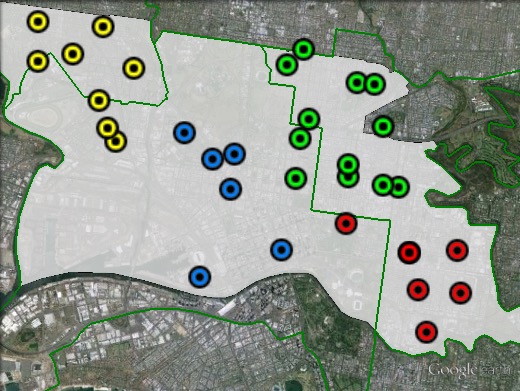
Booth breakdown
Booths have been divided into four areas. Booths around Ascot Vale and Kensington have been grouped as West. Fitzroy, Carlton and Abbotsford are grouped as North-East. East Melbourne and Richmond are grouped as South-East. Booths close to the Melbourne CBD are grouped as Central.
The Greens two-candidate-preferred vote ranged from 49% in the south-east to 62% in the north-east, winning three out of four areas.
The Greens topped the primary vote in all four areas, ranging from 36.6% in the south-east to 53% in the north-east.
Labor’s primary vote ranged from 25% in the north-east to 32% in the north-west. Labor came second in three out of four areas.
The Liberal Party’s vote ranged from 15% in the north-east to 29% in the south-east, outpolling Labor in the south-east.
| Voter group | GRN % | ALP % | LIB % | Total votes | % of votes |
| North-East | 52.9 | 25.1 | 15.1 | 17,274 | 20.4 |
| South-East | 36.6 | 27.2 | 28.8 | 12,996 | 15.4 |
| North-West | 40.4 | 31.9 | 20.3 | 10,659 | 12.6 |
| Central | 44.1 | 25.8 | 21.5 | 10,284 | 12.2 |
| Other votes | 39.9 | 25.7 | 25.8 | 33,338 | 39.4 |
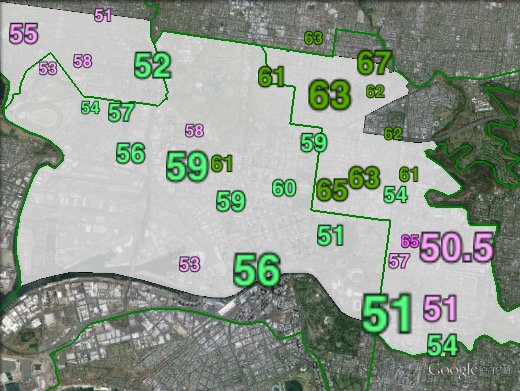
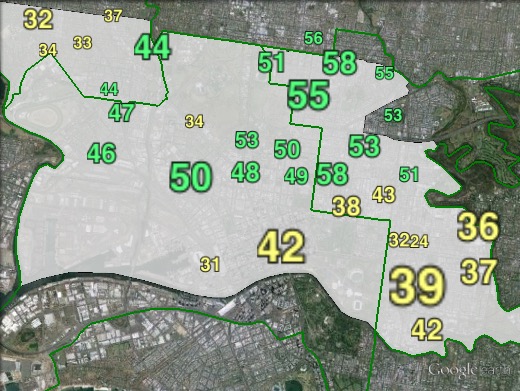
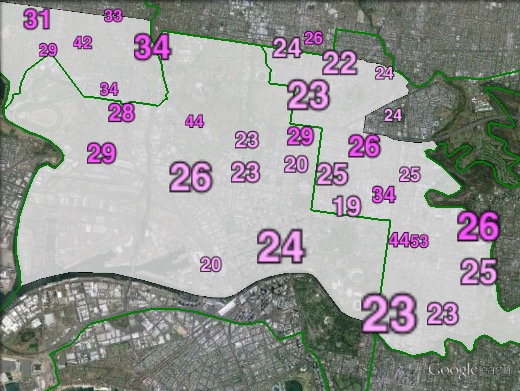
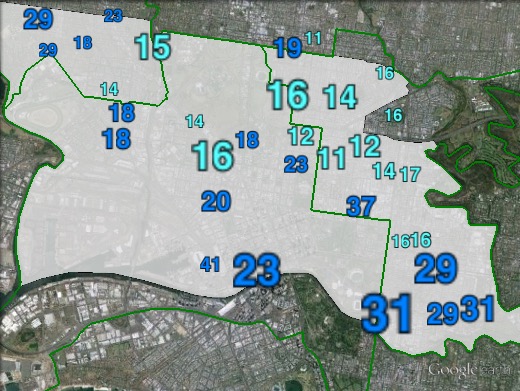


It’s hard to see Bandt being dislodged here.
Adam Bandt will retain this seat easily, with an increased TPP and primary vote.
Seats that are Labor vs Greens contest tend to behave in such a way that the Greens play the role of the Labor Party (left) elsewhere, and Labor the role of the Liberal Party (right) elsewhere. With a swing against the right expected – one should expect the Greens TPP vote to increase in this seat.
Huge field of sixteen last time kind of makes the threat by the Alliance for Progress to flood this seat with micro-party candidates preferencing Labor seem like nothing new and very unlikely to have any more impact on the result than the huge field did last time.
Can’t see Bandt losing this. Over time this will just become even harder for Labor to win. At the next redistribution I’d expect most of the north western booths to be moved to Maribyrnong.
Agreed. Labor is in a pickle here – Bandt should win it comfortably.
@Ben Raue, there is a line I just noticed that says the ALP have held the seat ever since William Maloney defeated Malcolm McEacharn in 1904. I assume this is from the old guide because since 2010, the Greens have won the seat twice!
Thanks. I’ll fix it now – sometimes out-of-date sentences slip through in the history.
What are people’s thoughts of this possibly impacting the result, assuming it isn’t all just a whole lot of hot air?
http://www.huffingtonpost.com.au/2016/03/06/senate-minor-party_n_9395902.html
This will have an impact. However even if it were to be a large one ( ie 1/2 dozen seats ) . I doubt it would change the overall outcome.
The country is still better off having started senate reform The big step will be making the senate representative. One senate seat for every 2, 3, 4,seats in the H of R. & none for the territories !!!.
I disagree – it will have bugger all impact, because the micro parties just don’t have the boots on the ground to distribute HTVs and therefore influence the distribution of preferences. Hell, the Greens struggle and they’ve got an order of magnitude more people power available.
(No Senate representation for the territories? Give off, the ACT is already wildly underrepresented in Parliament as it is! Not that your reform ideas have a snowball’s chance in hell anyway – the Constitution requires a referendum that reduces a State’s representation to pass in that State, good luck getting the Tasmanians to vote themselves out of the Senate).
kme
I’D love to be wrong. Truly i would.
What do you think about the idea, that minor party voters barely need an HTV ??. I don’t !!.
THE ACT is about to get seat no3. That is more than enough representation !!!.
Besides, Jeff KENNETT (& i’ would) like to abolish both territories , & federate SA, VIC, & TAS, Into one state !!!.
Now that would be a cost saving measure !!!
Can’t see Bandt losing in Melbourne, probably only a matter of what the TTP margin is depending on the Libs HTV as it is looking highly likely they’ll remain third.
Yeah, likely safe retain. Labor has a good candidate here but will be heavily outspent and probably solidly outcampaigned.
The Sex Party are running a candidate here, at least according to this Facebook page: https://www.facebook.com/lewisaustralia/?fref=ts
It also looks like at one stage he was running as an Independent in Lalor…
I think the only way the ALP could win back Melbourne would be parachuting in a celebrity candidate. Even then they would struggle and the candidate would have to be someone who has strong links to Melbourne.
Yep the threat of an orchestrated micro-party campaign here turned out to be hot air. Some of those parties have even preferenced the Greens in the Senate ahead of their ‘allies’!
NT has been taken care of in the house of Reps effectively guaranteeing it two seats – ACT seats are more than double the NT in size. There should be a third seat here now.
Greens ran huge campaign in 2013 which paid off but these resources will be elsewhere this yearin Batman & Higgins.It is electorate with very high population turnover so less opportunity to build personal votes. Seat polls have shown Labor vote up here, some of these voters could be Labor identifiers who will turn up & vote for Bandt but perhaps Labor might do better here than most think?
My prediction: Green hold.
What are the chances of the Labor candidate coming 3rd, changing the seat from Marginal GRN vs LAB to Safe GRN vs LIB?
In 2016? I doubt it.
Longer term, it probably will, in the same way that Grayndler and Sydney probably will. Affluent high-rise will eventually pave over the grungy, trendy, and remaining working class areas. But we’re talking “longer” term here….
I doubt it’ll happen any time soon, but if it does happen, I suspect it will be less growth of Liberal vote, and more shifting of Labor votes to the Greens. The “affluent” high-rise in Melbourne is likely to be more populated by people who lean towards the Greens, I think. Specifically, because of how Melbourne is laid out.
The Liberals have a decent chance of finishing in second place here, especially after declaration votes are counted. They are no threat to winning the seat any time soon, but it’s a least kind of interesting if Melbourne becomes a Greens v Lib contest even if only in name.
Labor finished third in every booth south of Victoria Street except the two North Richmond housing commission booths.
The AEC is now re-calculating the 2CP as between Bandt and Liu, so it seems the Liberals did indeed finish second here after preferences.